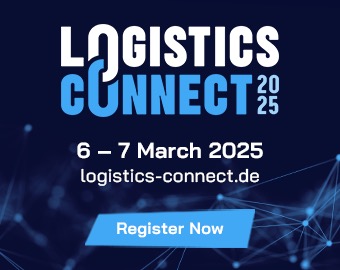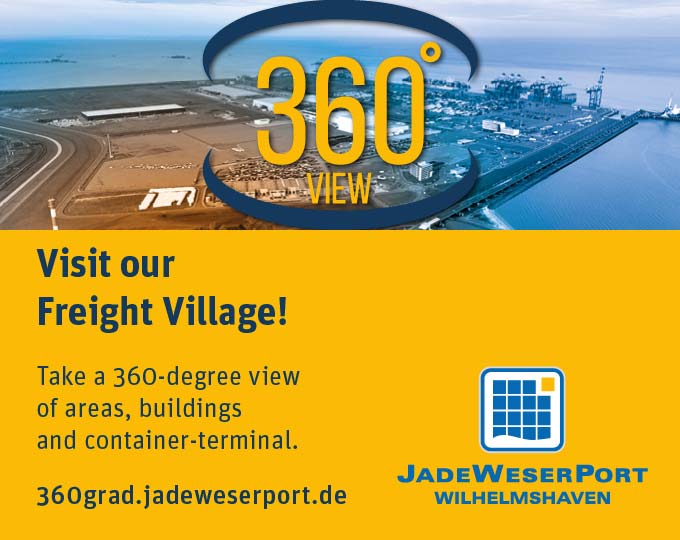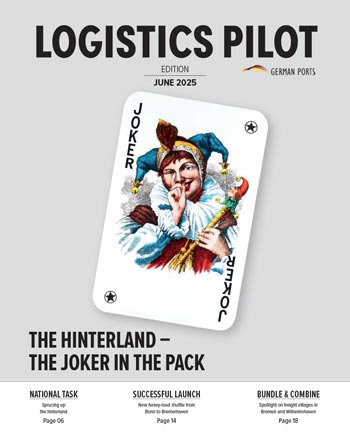Hand on heart, who doesn’t envy the Scandinavians? Once again they’ve come out top in the World Happiness Report. Economically, too, our friends in the North are some of Germany’s most important trading partners.
Photos: Falco/Pixabay, Kess KLine, WFB/Frank Pusch, Erich Westendarp/Pixabay
The latest World Happiness Report shows that, when it comes to life satisfaction, no-one beats the Scandics. With Finland, Denmark, Norway and Sweden occupying first, second, fifth and seventh place respectively, they dominate the top ten. For many people Scandinavia is synonymous with stable political and economic conditions, high educational standards and the adoption of new technologies. Economically, too, the group score highly in GDP (see pages 4 and 5) and the Doing Business index. This latter ranking, which is drawn up annually by the World Bank, uses ten indicators to examine how difficult it is to set up a business in a country, the effort required to obtain building permits, and how easy it is to access credit and electricity. The Doing Business Index for 2020 puts Denmark in fourth place, Norway in ninth, Sweden in tenth and Finland in twentieth, two places ahead of Germany.
Valued partners for Bremen and Lower Saxony
Our northern neighbours are also of great importance for the maritime economy in Lower Saxony and Bremen. “The Scandinavian region is often underestimated in its importance for Bremen’s ports,” says bremenports managing director Robert Howe. “Sweden, Finland, Norway and Denmark are also among our most important foreign trade regions worldwide, with around 8.1 million tonnes of imports and around 2.9 million tonnes of exports.” Every sixth tonne of sea cargo handled in the Bremen ports comes from or goes to Scandinavia. “This clearly makes northern Europe the number one destination among all European destinations,” says Howe. “These figures are testament to the many long-standing and proven partnerships between us.” “This also applies to Germany as a whole, because the Scandinavian countries have occupied a prominent position in the current account balance of Lower Saxony’s ports for years,” says André Heim, marketing manager at Seaports of Lower Saxony. “A wide range of different types of goods pass through the quay, especially cars, containers, forest products, trucks, RoRo transport and project cargo.” The JadeWeserPort also plays an important role here. “As the easternmost deep-water port in the North Range, we have optimal conditions to act as a hub for cargo volumes in Scandinavia,” says Andreas Bullwinkel, managing director of Container Terminal Wilhelmshaven JadeWeserPort-Marketing. “JadeWeserPort is connected to the numerous feeder ports in Scandinavia via several weekly routes in the Baltic Sea region. The Scandinavian countries represent an indispensable trading partner for us, especially in short sea traffic.” The following statements from the companies KESS, BLG LOGISTICS and Cuxport show which challenges the partners have to contend with in their daily business, which strategies they use in their respective markets and which specific features characterise trade with Scandinavia.
The 7,845m Öresund Bridge, which connects Copenhagen with Malmö, brings numerous new cars to Denmark by truck.
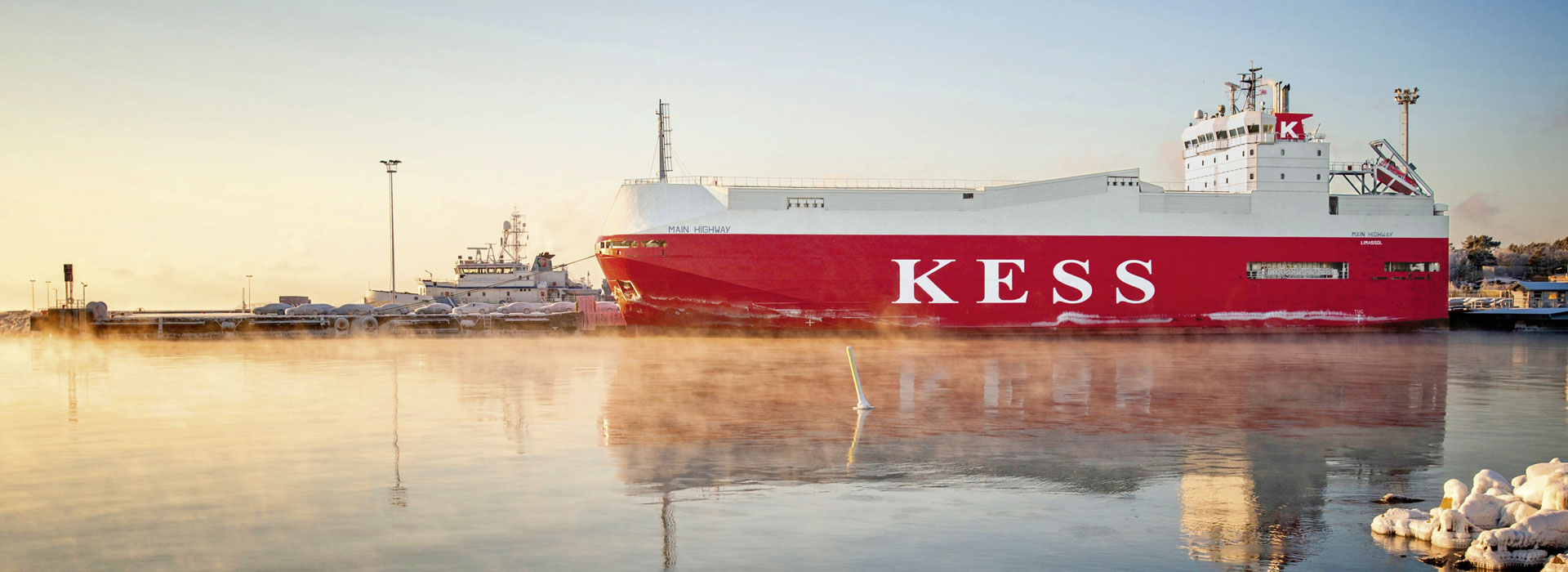
The markets in Scandinavia cover about 30 percent of the total volume of K-Line subsidiary KESS.
Customers follow their own individual strategies
Through its subsidiary K-Line European Sea Highway Services (KESS), founded in 2003, the Japanese shipping company K-Line transports up to 900,000 vehicles annually with eleven car carriers in European short-haul traffic. “Eight of these ships, carrying up to 1,500 cars, are regularly calling at ports in Scandinavia. The market there covers about 30 percent of our total volume,” says Jan Hagemann, general manager at KESS, outlining his company’s role around the Scandinavian peninsula. The strongest market for KESS in the region is Sweden, with up to seven calls per week. From Germany, the UK and Belgium, liner services call at the ports of Malmö, Halmstad and Södertälje (near Stockholm) several times a week. Each car manufacturer has developed its own individual strategy for which port to use to supply the market from this hub,” says Hagemann, explaining the different logistics chains in the automotive industry that are characteristic of the Swedish market. KESS handles its second highest volume in Scandinavia via Finland with two to three arrivals per week. This is because over 100,000 passenger cars are built there per year on behalf of a German car manufacturer. “Finland is currently the strongest export country for us in Scandinavia,” says Hagemann. The focus is particularly on the port of Uusikaupunki, from where shipments are made to Bremerhaven and then around the world. “In the past, the frequency of departures was even higher than today because Finland was an important transit country for the Russian market. Since then the Russians have pushed ahead with the modernisation of their ports and their infrastructure to such an extent that they can do a lot on their own,” he explains. Since the KESS fleet was largely built to the highest ice class 1A, the shipping company is able to guarantee supplies in Finland throughout the year, even under difficult weather conditions. The smallest market for KESS in Scandinavia is Denmark, with about one to two calls per month. Automotive logistics for Germany’s northern neighbours are usually handled via ports in Sweden or Bremerhaven, from where they are forwarded by road. As for Norway, it is not currently served by the K-Line subsidiary. “In general, Scandinavia is an important market for us. It has a relatively stable economy and a constant level of car sales, which are distributed evenly throughout the year. In comparison, the UK market, for example, is subject to considerable seasonal fluctuations,” say Hagemann. On the other hand, the rapid growth in e-mobility, especially in Sweden and Norway, as well as the environmental awareness of the Scandinavians, pose real challenges for his company. Hagemann points to the growing transport volumes of e-vehicles. “At first glance, this would not seem to make any difference. But since e-vehicles are equipped with a much heavier battery than conventional passenger cars, and this battery is also associated with higher fire hazard potential, this makes a considerable difference to shipping companies’ cargo plans.
Most read
Logistics Pilot
The current print edition - request it now free of charge.
With over 2.3 million vehicles per year, the Bremerhaven car terminal is one of the largest car ports in the world.
Cars are the route to success
Good connections to the north are also important for BLG LOGISTICS (BLG), especially in the automotive sector. “Of the more than six million vehicles that we transport each year, we ship more than 320,000 from or to Scandinavia,” says Stefan Nousch, marketing and sales director at BLG Automobile Logistics. Of these, around 140,000 vehicles are from Sweden, 110,000 from Finland and 70,000 from Norway. From the German point of view, the high-sales market of Sweden is primarily an export market, for which which Cuxhaven functions as BLG’s main transhipment centre. From there, the seaport and logistics service provider controls the transport of the Volkswagen, BMW and Mercedes brands by short-sea feeder. In vehicle transport with Finland, however, BLG acts predominantly as an import port operator. The cars produced there are brought to Bremerhaven on two ships a week before they are sent on to the European market or overseas. Parallel to this, Bremerhaven is the BLG hub for car exports to Norway. The site is the port of departure for both German manufacturers and import vehicles from the Far East. Like KESS, BLG also has a high proportion of e-vehicles in the Norwegian market. “The share of these EVs is around 30 percent,” says Nousch. “For us, however, handling them is no different from handling conventional cars, as we load the cars according to the stowage plans of the shipping companies.” Nousch sees the sometimes limited parking space capacities in the ports there as a particular challenge in doing business with the Scandinavian countries. “Since for many customers we assume a buffer function, we have to look closely at how we can find the right mix between the quantities requested and the local space available,” explains Nousch. Looking ahead, he has one idea in mind that he would like to introduce to his business partners in Sweden: “For historical reasons, the Scandinavians are very water-heavy in their transport chains. But rail offers very a good opportunity to handle more traffic by rail.” The railway infrastructure in Sweden is well designed for this, he says, as demonstrated by field tests that BLG carried out for Volkswagen at the beginning of this year with test trains. “This option would help the environment and port operations. It would also save a considerable amount of time. Train delivery from the VW plant to their Swedish destination took around 24 to 36 hours, while the same delivery by water took between 96 and 120 hours,” says Nousch.
In trade with Scandinavia, paper and cellulose products are among the main cargo handled. Major BLG business partners in this market have their headquarters in Sweden and Finland.
Forest products another important element
Alongside car transport, the shipping of paper and cellulose products is another key element of BLG’s business with Scandinavia. This area of of the logistics company’s activity – together with steel products, machines and other XXL goods – is assigned to the breakbulk sector and is largely managed from the Neustadt port. “Our focus here is on Sweden with 200,000 tonnes of kraftliner per year and Finland with about 60,000 tonnes of bale cellulose and about 30,000 tonnes of kraftliner per year”, says Horst Kaupke, sales and marketing manager at BLG. Bremen has been the port of choice for Smurfit Kappa in this market for more than 50 years. In Piteå in northern Sweden, the company operates the largest paper mill for kraftliner in Europe and supplies its own folding boxboard plants in Germany with packaging paper via BLG in the Neustadt port. “Every Monday we dispatch a RoRo ship with paper rolls from the North in Neustadt harbour. In total, Scandinavian volume accounts for about 20 percent of all handling,” says Kaupke. This also includes sawn timber from Sweden, which is transported to Bremen and from there shipped to the US. The same applies to special cellulose, which comes from the USA and is destined for Denmark.
Coronovirus halts Cuxhaven’s growth strategy
In recent years, Cuxhaven has developed into an important international hub for Scandinavian traffic. Every year recently, the third largest car port in Germany has shipped more than 390,000 new cars from name manufacturers to and from the UK and Scandinavia. “Thanks to its good connections, the location is highly attractive for producers and transporters from the Scandinavian countries,” says Arne Ehlers, deputy chairman of the Port Economic Community of Cuxhaven (HWG) and managing director of Blue Water BREB. Against this background, the Swedish market is served by KESS with two weekly departures from the BLG terminal. Cuxport also functions as a transhipment centre for the dispatch of new vehicles to Denmark and Sweden by truck and ship. The range of services is rounded off by the weekly transport of high-and-heavy project loads with the Wagenborg shipping company’s RoRo line from the Cuxport terminal to the Swedish ports of Södertälje and Piteå. In addition, Turku in Finland is served by Mann Lines with a liner service. “Due to the effects of the pandemic on the global economy, however, many ships are currently lying up and many liner shipping companies are only operating very sparsely,” says Oliver Fuhljahn, head of automobile logistics at Cuxport and Cuxhaven and location manager for the Seaports of Lower Saxony. “We are therefore not expecting any significant increases and currently regard the Scandinavian market as static,” he adds. “But we expect a slow recovery as soon as production starts up again.” (bre)
“Soft on people, tough in business.”
Interview with Thomas Ryberg, president and chief executive of the Swedish Chamber of Commerce in Germany
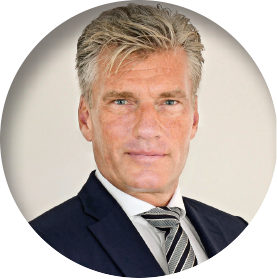
Scandinavia is much more than elk, home furniture, crispbread and safe cars. In your experience, which industries play an important role in trade between Sweden and Germany? Ryberg: Swedish-German relations have a long tradition, and Germany is Sweden’s largest international trading partner in both import and export. Swedes value Made in Germany as a mark of quality, especially for equipment, cars and chemical products. Many German companies have established a presence in Stockholm, Gothenburg and Malmö. Currently the region around Gothenburg is booming, because from there Oslo and Copenhagen are just three hours away. Conversely, paper and paper products, but also equipment and engineering technology, as well as pharmaceutical products and cars from Sweden, are in high demand in Germany. What should German companies be aware of when they move to Sweden? Ryberg: There are various ways in which Germans and Swedes are more similar than people think. But there are also little things in which we differ and that can lead to unpleasant situations if we ignore them. For example, we Swedes have a much less hierarchical way of thinking and, as a result, a different way of making business decisions. For us, consensus is particularly important. For Germans this can take some getting used to. But I admit that sometimes we Swedes are also a bit strange. Many of us go out and buy products just because they are new, whereas Germans usually buy them only after careful consideration. Although once they have decided on a brand, they stay loyal to it longer than we do. What special opportunities does trade between Germany and Sweden offer? Ryberg: A good example of efficient cooperation is the German-Swedish innovation partnership. The German Chancellor Angela Merkel and Swedish Prime Minister Stefan Löfven signed the agreement in 2017, and it was extended last year at the Hanover Fair to include batteries and AI. In addition to digitalisation and the boosting of development and research in SMEs, the main focus will be on e-health, mobility and testbeds for industry 4.0. These are all areas in which both countries have strong potential and where cooperation will also strengthen the international importance of the EU. Is the Nordic tradition of seafaring, trade and the Vikings still reflected in trade with Scandinavia today? Ryberg: I think so, because throughout their history the peoples of Scandinavia have learned trade from the bottom up. But we are often underestimated. And then our business partners get all the more irritated when we Northerners make difficult decisions with a smile on our face so as not to be ripped off. We are soft on people, but tough in business.

